Samsung Portable SSD T3 Review
by Ganesh T S on February 22, 2016 10:00 AM ESTSynthetic Benchmarks - ATTO and Crystal DiskMark
Samsung claims sequential read and write speeds of up to 450 MBps, and these are backed up by the ATTO benchmarks provided below. Unfortunately, these access traces are not very common in real-life scenarios.
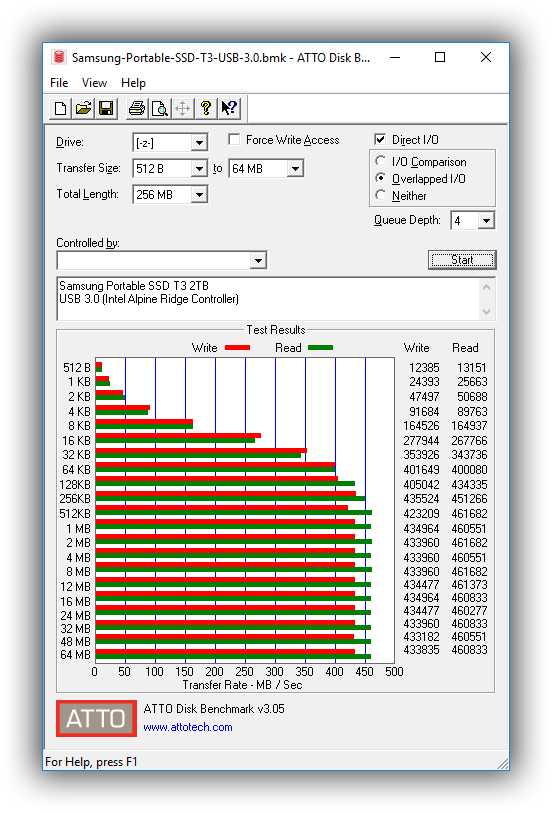
CrystalDiskMark, despite being a canned benchmark, provides a better estimate of the performance range with a selected set of numbers. As evident from the screenshot below, the performance can dip to as low as 20.68 MBps for random 4K reads. The presence of DRAM helps boost the performance quite a bit.
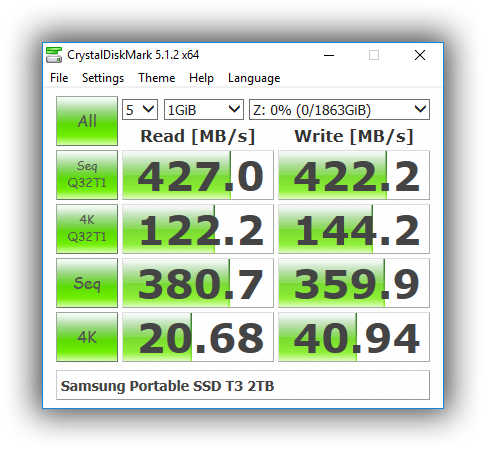
Benchmarks - robocopy and PCMark 8 Storage Bench
Our testing methodology for DAS units also takes into consideration the usual use-case for such devices. The most common usage scenario is transfer of large amounts of photos and videos to and from the unit. The minor usage scenario is importing files directly off the DAS into a multimedia editing program such as Adobe Photoshop.
In order to tackle the first use-case, we created three test folders with the following characteristics:
- Photos: 15.6 GB collection of 4320 photos (RAW as well as JPEGs) in 61 sub-folders
- Videos: 16.1 GB collection of 244 videos (MP4 as well as MOVs) in 6 sub-folders
- BR: 10.7 GB Blu-ray folder structure of the IDT Benchmark Blu-ray (the same that we use in our robocopy tests for NAS systems)






In almost all the cases, we find that the performance of the T3 slightly lags the performance of the T1. However, it is still faster than most other SSDs behind a SATA - USB bridge chip.
For the second use-case, we take advantage of PC Mark 8's storage bench. The storage workload involves games as well as multimedia editing applications. The command line version allows us to cherry-pick storage traces to run on a target drive. We chose the following traces.
- Adobe Photoshop (Light)
- Adobe Photoshop (Heavy)
- Adobe After Effects
- Adobe Illustrator
Usually, PC Mark 8 reports time to complete the trace, but the detailed log report has the read and write bandwidth figures which we present in our performance graphs. Note that the bandwidth number reported in the results don't involve idle time compression. Results might appear low, but that is part of the workload characteristic. Note that the same testbed is being used for all DAS units. Therefore, comparing the numbers for each trace should be possible across different DAS units. These benchmarks also point to the T3 being slightly behind T1 in performance.


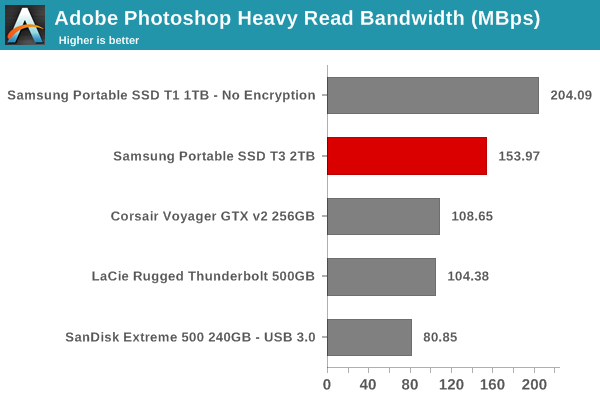


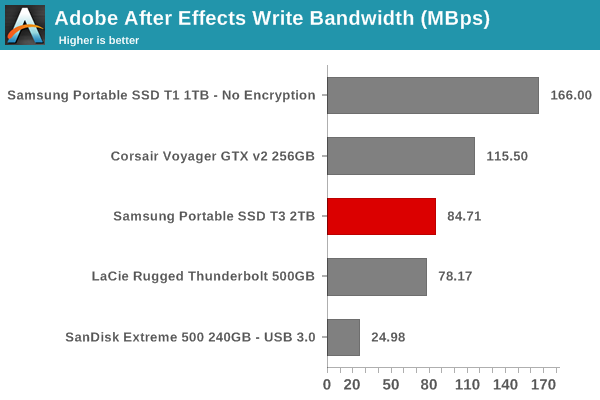
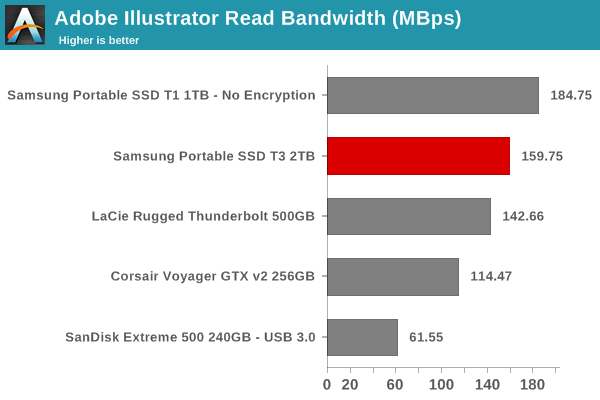











49 Comments
View All Comments
bill44 - Monday, February 22, 2016 - link
"In a bus-powered enclosure, it is difficult to put incorporate PCIe SSDs."USB 3.1 Gen 2 can provide more power (don't know if that's enough though). TB3 can go one better (up to 100W).
Would be nice to see a PCIe 3 x 4 SSD in a USB 3.1 Gen 2 or TB3 enclosure that does not use SATA mode.
Doubt we will ever see a bridge-chipset other than what we see here (that uses SATA mode).
ganeshts - Monday, February 22, 2016 - link
It will be risky for device vendors to implement. The reason is that most PC or phone USB Type-C ports will only implement the minimum required option - which is 5V at 900mA - even with 3.1 Gen 2 ports. If you have a drive with higher power requirements, it might not be compatible with many of the USB ports out there - only those that implement USB Power Delivery (where the minimum is 5V at 2A).Yes, Thunderbolt 3 does provide a little bit of leeway - 15W is the minimum (5V at 3A).
BillyONeal - Monday, February 22, 2016 - link
The connector standard provides that much power, but few implementations actually do.bill44 - Monday, February 22, 2016 - link
If we always take the lowest common denominator, we will never move forward. I see your point though, but shouldn't there be a power user option? We have the tech where a single (non-raid) PCIe SSD would be able to saturate the 3.1 Gen 2 interface, but, if We want performance, we have to make do with 2x SATA SSDs in RAID. Which is more expensive and not as fast.Leosch - Tuesday, March 15, 2016 - link
Sorry but this is wrong and irks me to read again and again.100 W is not provided by Thunderbolt 3, but by USB Power Delivery 2.0. Thunderbolt 3.0 also does not have additional protocols as the article claims but is instead one of multiple USB Alternate Modes the most popular of the others being Display Port 1.2.
So many great features of the new USB standards and the new USB connecter get ascribed to Thunderbolt 3 even though it is just piggybacking as an alternate mode over the same link.
lordmocha - Sunday, March 27, 2016 - link
Why do you say TB3 can go one better than USB 3.1 Gen 2? What about USB Power Delivery 1.2 which is 100W which you can get in a Type-C port without TB3 capability...Magichands8 - Monday, February 22, 2016 - link
So TRIM support is indeterminate? I'd really like to know why there wasn't even an attempt to see if it could be established with this drive. As a potential buyer I would be really interested in knowing if the T3 is going to gradually turn into a paperweight just from normal use. It's kind of relevant.dano_spumoni - Wednesday, February 24, 2016 - link
yes, it's disturbing that they won't at least confirm or deny TRIM support, it's kind of a big deal for an expensive external SSD.name99 - Monday, February 22, 2016 - link
Why did you not give the power required (at maximum usage, generally lots of back-to-back random writes)?This is especially important for bus-powered drives because it tells us whether the drive can (or cannot) usefully be connected to an old-style USB-2 computer, or whether we need to be especially careful in how much power we provide to a USB-3 hub.
royalcrown - Monday, February 22, 2016 - link
$ 850 USD for 2 TB...no thank you.